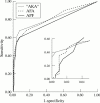Anti-perinuclear factor compared with the so called "antikeratin" antibodies and antibodies to human epidermis filaggrin, in the diagnosis of arthritides
- PMID: 10343539
- PMCID: PMC1752764
- DOI: 10.1136/ard.58.1.42
Anti-perinuclear factor compared with the so called "antikeratin" antibodies and antibodies to human epidermis filaggrin, in the diagnosis of arthritides
Abstract
Objective: Antiperinuclear factor (APF), "antikeratin antibodies" ("AKA"), and antibodies to human epidermis filaggrin (AFA), are highly specific serological markers of rheumatoid arthritis (RA), which recognise epitopes on various isoforms of (pro)filaggrin. It was proposed that these antibodies are globally named antifilaggrin autoantibodies. Here the diagnostic value of the detection of each one is compared and the overlap between the three tests evaluated.
Methods: 492 serum samples were tested, including 279 RA serum samples, taken from patients in France and Belgium. APF and "AKA" titres were estimated by indirect immunofluorescence, and AFA titres by immunoblotting on filaggrin enriched human epidermis extracts.
Results: By a convenient choice of the positivity thresholds, the diagnostic sensitivity and specificity of the tests were shown to be similar (0.52 and 0.97, respectively). Although the antibody titres were strongly correlated, the associations APF-AFA or AFA-"AKA" permitted more than 52% or 55% of RA to be diagnosed, with a specificity of 0.99.
Conclusion: APF, "AKA", and AFA detection have a similar diagnostic value. However, because the three tests do not totally overlap, associating APF with "AKA" or AFA with "AKA" can improve diagnostic sensitivity. None of the three antigens used bear all the epitopes recognised by antifilaggrin autoantibodies.
Figures



Similar articles
-
Immunoblotting detection of autoantibodies to human epidermis filaggrin: a new diagnostic test for rheumatoid arthritis.J Rheumatol. 1998 May;25(5):838-46. J Rheumatol. 1998. PMID: 9598877
-
The antiperinuclear factor and the so-called antikeratin antibodies are the same rheumatoid arthritis-specific autoantibodies.J Clin Invest. 1995 Jun;95(6):2672-9. doi: 10.1172/JCI117969. J Clin Invest. 1995. PMID: 7539459 Free PMC article.
-
Performance of two ELISAs for antifilaggrin autoantibodies, using either affinity purified or deiminated recombinant human filaggrin, in the diagnosis of rheumatoid arthritis.Ann Rheum Dis. 2001 Sep;60(9):882-7. Ann Rheum Dis. 2001. PMID: 11502616 Free PMC article.
-
The antiperinuclear factor and antikeratin antibody systems.Int Arch Allergy Immunol. 1995 Aug;107(4):508-18. doi: 10.1159/000237093. Int Arch Allergy Immunol. 1995. PMID: 7542514 Review.
-
Marker antibodies of rheumatoid arthritis: diagnostic and pathogenetic implications.Semin Arthritis Rheum. 1994 Jun;23(6):379-87. doi: 10.1016/0049-0172(94)90088-4. Semin Arthritis Rheum. 1994. PMID: 7524151 Review.
Cited by
-
Induction of osteoclastogenesis and bone loss by human autoantibodies against citrullinated vimentin.J Clin Invest. 2012 May;122(5):1791-802. doi: 10.1172/JCI60975. Epub 2012 Apr 16. J Clin Invest. 2012. PMID: 22505457 Free PMC article.
-
New insights into the impact of neuro-inflammation in rheumatoid arthritis.Front Neurosci. 2014 Nov 6;8:357. doi: 10.3389/fnins.2014.00357. eCollection 2014. Front Neurosci. 2014. PMID: 25414636 Free PMC article. Review.
-
Correlation of anti-cyclic citrullinated antibody with hand joint erosion score in rheumatoid arthritis patients.Korean J Intern Med. 2010 Jun;25(2):201-6. doi: 10.3904/kjim.2010.25.2.201. Epub 2010 Jun 1. Korean J Intern Med. 2010. PMID: 20526395 Free PMC article.
-
Synovial fibroblast-neutrophil interactions promote pathogenic adaptive immunity in rheumatoid arthritis.Sci Immunol. 2017 Apr;2(10):eaag3358. doi: 10.1126/sciimmunol.aag3358. Epub 2017 Apr 14. Sci Immunol. 2017. PMID: 28649674 Free PMC article.
-
Rheumatoid arthritis associated autoantibodies in patients with synovitis of recent onset.Arthritis Res. 2000;2(3):236-43. doi: 10.1186/ar93. Epub 2000 Mar 31. Arthritis Res. 2000. PMID: 11056669 Free PMC article.
References
Publication types
MeSH terms
Substances
LinkOut - more resources
Full Text Sources
Medical

